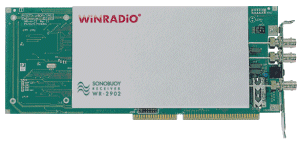
The WiNRADiO WR-2902i VHF Sonobuoy Receiver is designed to receive signals from analogue (DIFAR) and digital (BARRA) sonobuoy transmitters, operating in the 136 to 173.5 MHz frequency range. The receiver is specifically designed to suit high-performance multi-channel systems.
It consists of a self-contained ISA card designed to be plugged into a PC, together with control software and support documentation. As all RF signal processing is performed by the card, the PC hardware and software requirements are modest. Up to eight cards can be plugged into the same computer, and controlled separately and independently. With minor reconfiguration, this number can be increased to 256.

The card is fully shielded and protected against local electromagnetic noise, to ensure that it delivers full specified performance inside the host computer.
The receiver is a triple conversion superheterodyne. It features a single antenna input, separate analog and digital signal outputs, and an audio output for monitoring.
The receiver is supplied with Windows NT based application software and a DLL library for integration to the customer's system.
|